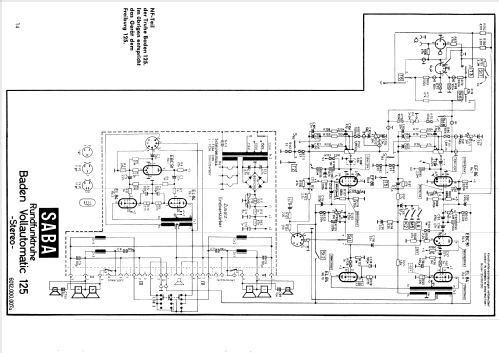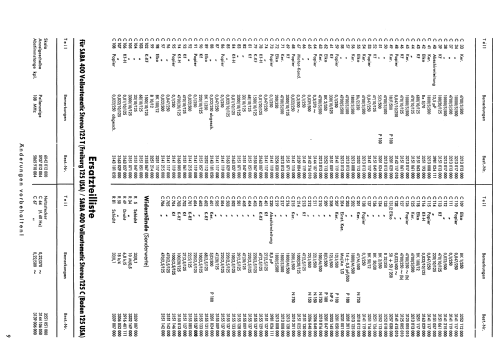Baden 125 USA 400 Vollautomatic Stereo/125C
SABA; Villingen
- Hersteller / Marke
- SABA; Villingen
- Jahr
- 1960/1961
- Kategorie
- Rundfunkempfänger (Radio - oder Tuner nach WW2)
- Radiomuseum.org ID
- 99419
-
- Marke: Schwer & Söhne, GmbH
Klicken Sie auf den Schaltplanausschnitt, um diesen kostenlos als Dokument anzufordern.
- Anzahl Röhren
- 16
- Hauptprinzip
- Superhet allgemein; ZF/IF 460/10700 kHz
- Anzahl Kreise
- 10 Kreis(e) AM 13 Kreis(e) FM
- Wellenbereiche
- Langwelle, Mittelwelle, Kurzwelle und UKW.
- Spezialitäten
- Plattenspieler (oder Wechsler)
- Betriebsart / Volt
- Wechselstromspeisung / 110; 125; 150; 220 Volt
- Lautsprecher
- 6 Lautsprecher
- Belastbarkeit / Leistung
- 20 W (Qualität unbekannt)
- Material
- Gerät mit Holzgehäuse
- von Radiomuseum.org
- Modell: Baden 125 USA 400 Vollautomatic Stereo/125C - SABA; Villingen
- Form
- Standgerät auf niedrigen Beinen (Beine < 50 % der Gesamthöhe).
- Abmessungen (BHT)
- 1920 x 900 x 470 mm / 75.6 x 35.4 x 18.5 inch
- Bemerkung
-
Exportgerät, Chassis Freiburg 125 mit UKW-Bereich bis 108 MHz; enthält separaten Zusatzverstärker für den 2. Kanal mit eigener Stromversorgung..
Abgleich (auch Steuerfilter)
Alignment (also automatic filter)
- Nettogewicht
- 142.5 kg / 313 lb 14 oz (313.877 lb)
- Literaturnachweis
- -- Original-techn. papers.
- Autor
- Modellseite von Walter Groer angelegt. Siehe bei "Änderungsvorschlag" für weitere Mitarbeit.
- Weitere Modelle
-
Hier finden Sie 1649 Modelle, davon 1507 mit Bildern und 1189 mit Schaltbildern.
Alle gelisteten Radios usw. von SABA; Villingen
Forumsbeiträge zum Modell: SABA; Villingen: Baden 125 USA 400 Vollautomatic Stereo/125C
Threads: 1 | Posts: 1
Hi;
I recently joined radiomuseum and am hoping someone can help me source some parts for my SABA 400 Vollautomatic Stereo/125C console. I have had the radio portion of the unit restored (bad tubes/capacitors/diodes/etc.) replaced, but there was no saving either the tuning or volume control motors. Both motors had at least one bad coil (resistance <1kOhm).
I had a donor unit (410 Continental US) but the motors in it were also bad. It was also not possible to remove the coils from one motor to add to the other, as the iron laminations of the core had expanded and were holding the plastic bobbins and coils extremely tightly. Removal of the coils would result in destroying the plastic bobbins.
I am hoping someone may have a source for working motors in North America or Europe, perhaps from a parts chassis.
Any help would be greatly appreciated!
Anlagen
Jonathan Sharples, 17.Jan.13

